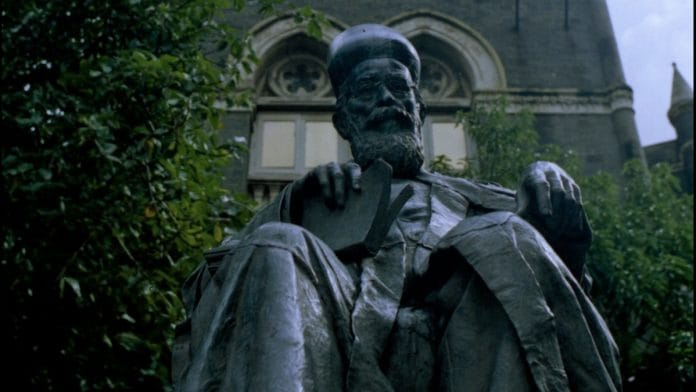New Delhi: In 1851, a 26-year-old Dadabhai Naoroji launched a fortnightly newspaper that served as a vessel for many of his reformist ideas – from women’s education and religious reform to criticising the Bombay Parsi Panchayat. The early editions of Rast Goftar or Truth Teller didn’t survive, but biographies on Naoroji highlight the paper’s outsized impact on the politics of the time.
“If you were a reformist in India between the 1820s and 1850s and you wanted to get your message out, you started a newspaper,” said Dinyar Patel, author of Naoroji: Pioneer of Indian Nationalism and assistant professor of history at S.P. Jain Institute of Management and Research. “At the time, Rast Goftar was one of the largest circulated papers in Western India.”
On 15 November 1851, a thousand copies of the first edition were distributed for free without a single advertisement in the paper, according to RP Masani’s Dadabhai Naoroji: The Grand Old Man of India. Naoroji hastened the launch of the paper on the back of tensions between the Muslim and Parsi communities of Bombay. The two communities had enjoyed cordial relations, but an image of the prophet Mohammed in a magazine – Chitra Dynan Darpan (The Illustrated Mirror) – edited by a Parsi youth, sparked riots.
“The people involved in the paper criticised the Parsi leadership for not doing enough to protect the community during the riots,” said Patel. Naoroji was entrusted by a group of Parsis to draft a petition to the government for compensation for the riots. “He started the paper right after the riots, but the idea had been brewing in his head for a long time,” Patel added.
Champion of rights
Naoroji was part of a group of people informally known as ‘Young Bombay’, a reformist clique with progressive views on women’s education and rationalisation of religious practices. Rast Goftar helped him propagate some of these views.
“One of Naoroji’s campaigns concerned the status of Indian widows. In those days, many people considered widows to be unlucky and to be avoided,” said Zerbanoo Gifford, author of Dadabhai Naoroji: Britain’s First Asian M.P. “His own mother had been widowed early in her life, and Naoroji wanted to remove the stigma around widowhood and enable them to remarry.”
Gifford went on to add that through the paper, Naoroji campaigned for academic classes for girls in Bombay, which sparked the first steps toward establishing female schools in the city. But starting the paper was a challenge for the ‘Grand Old Man of India’ – he didn’t have the means to finance it.
At the time, Bombay had five Gujarati newspapers, all owned by Parsis. Masani wrote that Naoroji approached his friend Kharshedji Nasarwanji Cama to provide funds for the venture. “While Dadabhai was the brain, Cama was the sinews, so to speak, of the journal,” he wrote.
Naoroji had edited the Dnyan Prasarak magazine, which included articles on philosophy and astronomy. He also contributed to the Gujarati daily Samachar Darpan, writing a series titled ‘Dialogues of Socrates and Diogenes.’ But the first three issues of Rast Goftar were focused exclusively on the Parsi-Muslim riots.
“One thing he did do is take the Bombay Parsi Panchayat to task because he felt they did not do a good enough job representing Parsi interests during the riots,” said Patel. According to Masani, Naoroji criticised both the police and Parsi leaders, accusing them of being indifferent to the plight of the community.
The paper gained significant traction in a short period after its launch. Readers demanded that it be converted to a weekly paper, according to Masani. The subscription price of two annas per month was kept low to encourage readership, but Naoroji hoped that people with the means would subsidise the paper by paying larger subscriptions. In January 1852, it was converted to a weekly and published every Sunday morning.
“The circulation peaked at maybe a thousand,” said Patel, highlighting that the reading population was not a lot in the mid-1800s. Over time, the paper transitioned from topics exclusively for Parsis to more national-level discussions around Indian politics. “But people would read it to groups of ten or twenty, so the actual reception of the paper was a lot larger.”
Also read: Who was Ramabai Ambedkar behind the songs & statues? She suffered, sacrificed, snapped back
First Asian MP in Britain
In 1855, Naoroji left India for the shores of England, where he would later become the first Asian Member of Parliament with the Liberal Party. Even though he had ceased most ties with the paper, he did send back his travel logs. This was particularly significant at the time because Naoroji was one of the first few educated Indians to travel abroad, according to Patel.
The logs showed how Naoroji experienced his journey, from Bombay to Cairo to London. “When he arrives in France and Great Britain, he is stunned by how modern and rich these societies are, which is important from his standpoint because later on he becomes the spokesperson for Indian poverty.”
Patel remarked that there were articles in the newspaper that detailed his experience in Aiden, a port city in modern-day Yemen, which was under the control of the British Empire at the time. Naoroji’s experience in Egypt was also published in the paper, where he observed that the country’s period of modernisation, which included building a railway system, was similar to India.
“He visits the 1855 Paris Exposition, where he witnesses the latest technology from around the world, including various machines and gas-powered street lamps,” said Patel, adding that Naoroji wrote back saying he was convinced he wanted his country to emulate France, with its advanced economy and standard of living.
Patel concluded that the tone of the paper changed from 1855 onwards, when one of the editors had pro-British views. But while Naoroji was in the driver’s seat, the paper represented his progressive ideas, advocating against business magnets, corruption, and the hoarding of political power.
(Edited by Ratan Priya)






